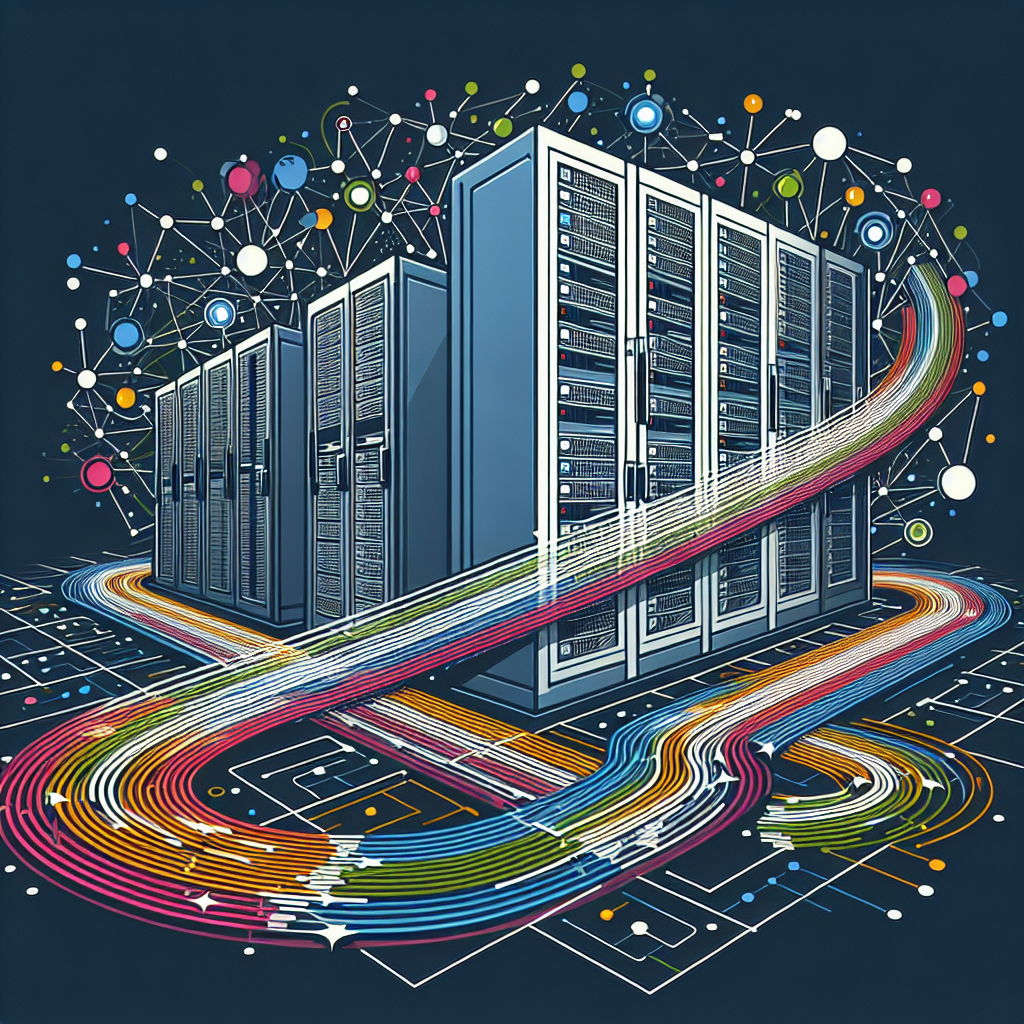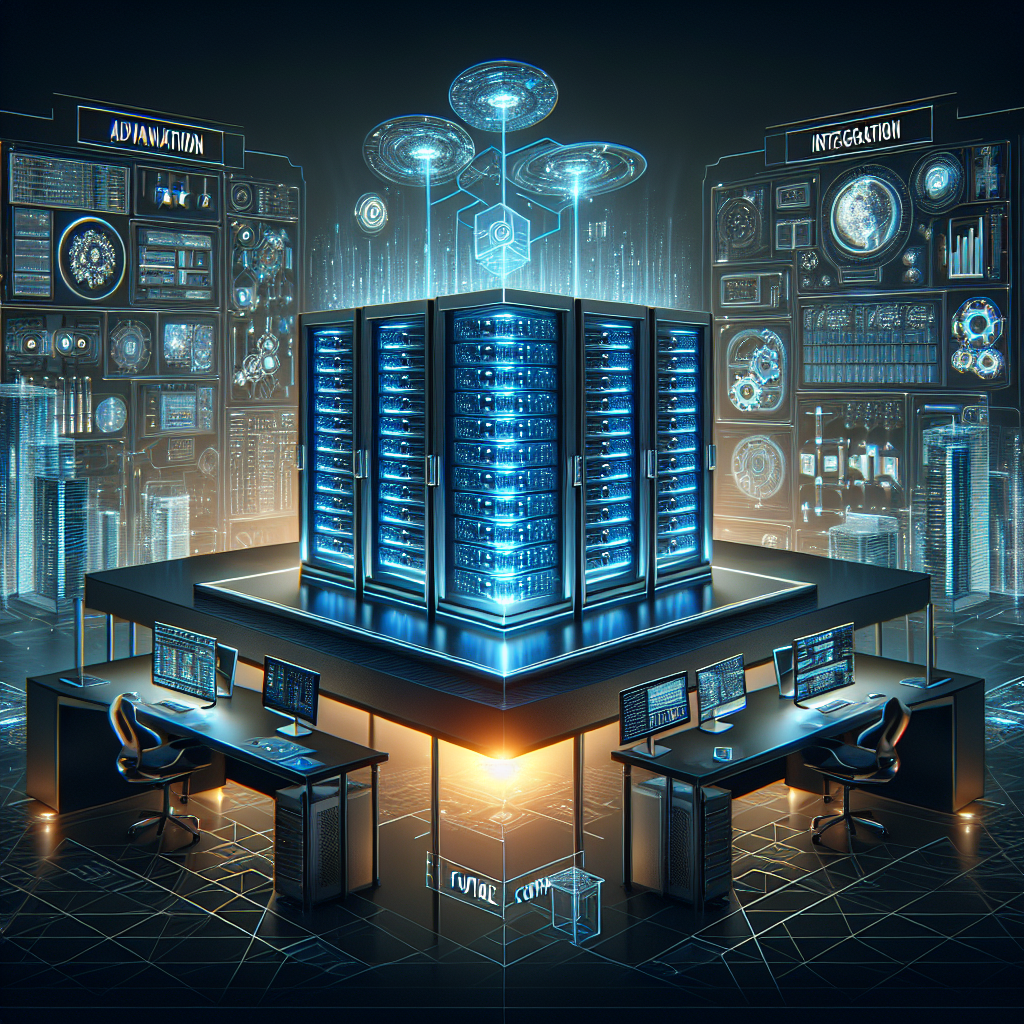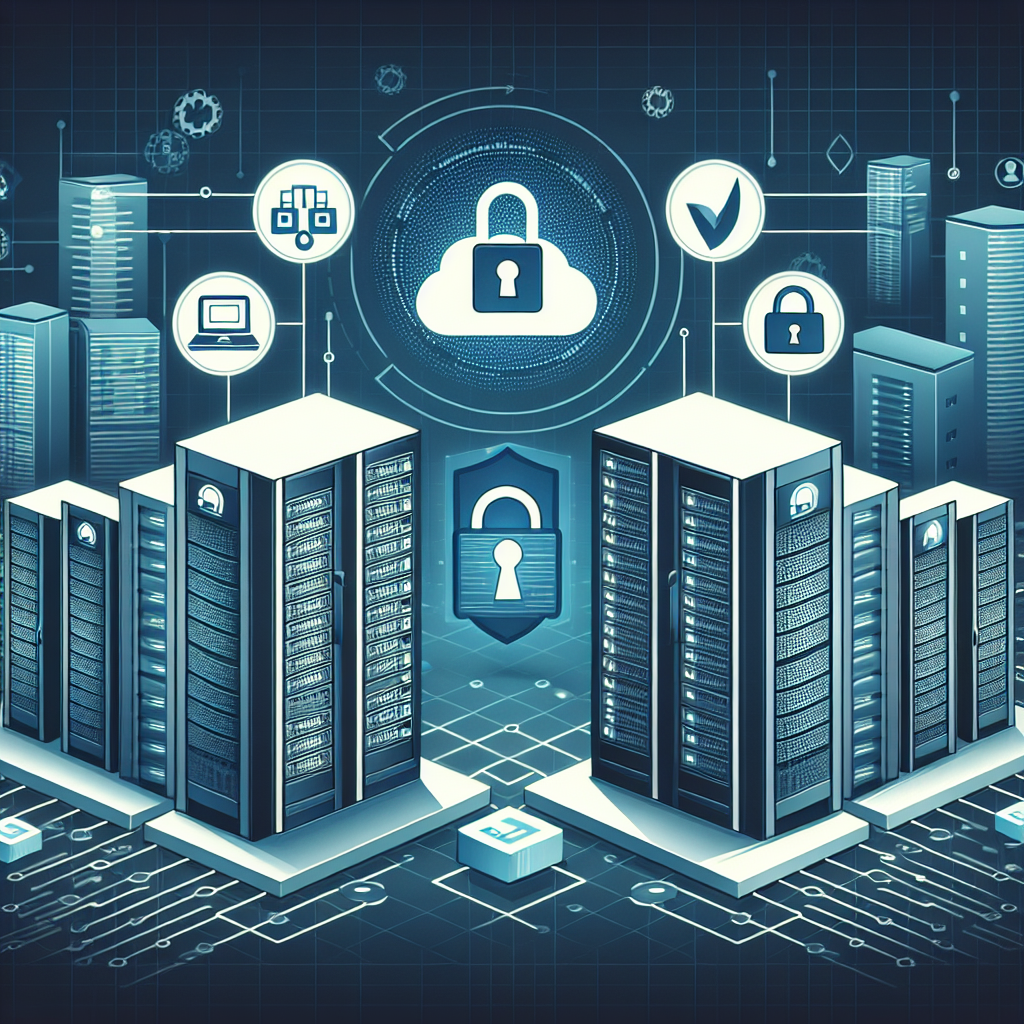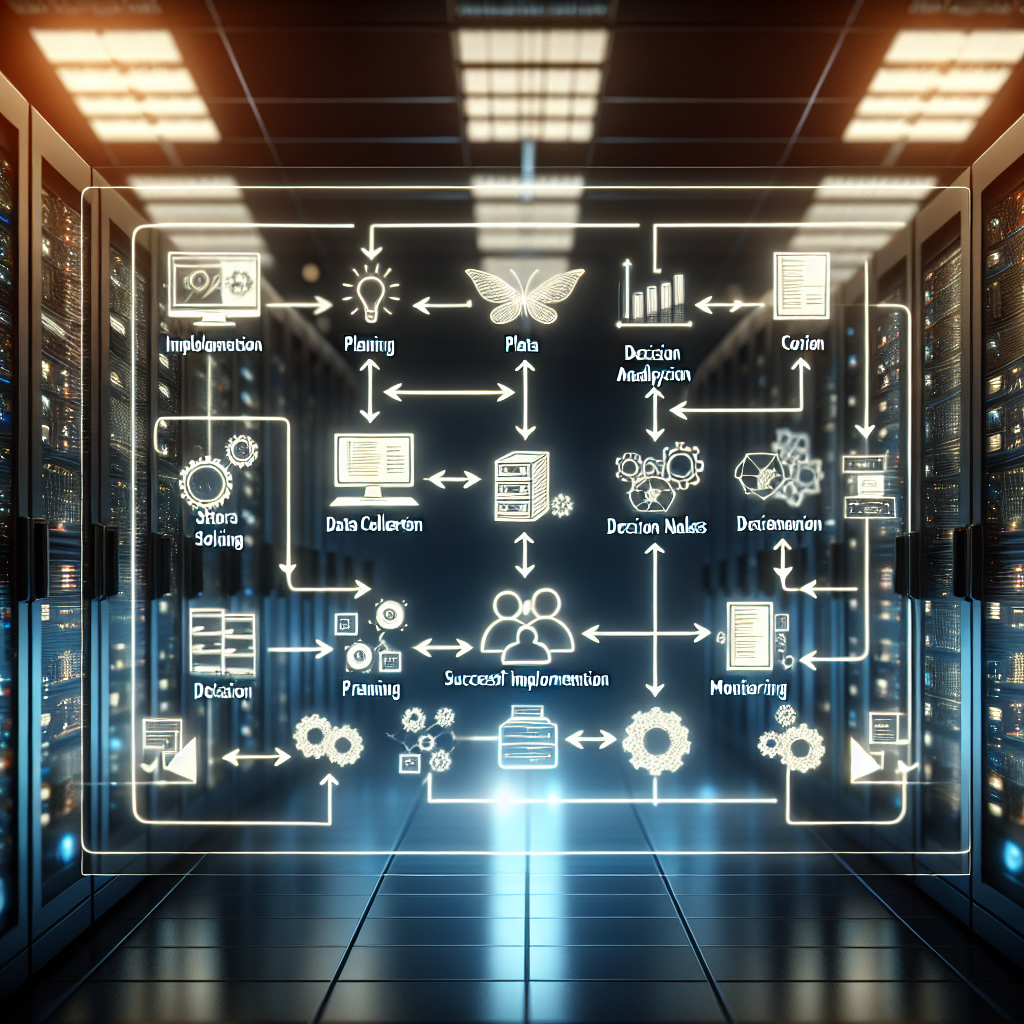Your cart is currently empty!
Tag: Data Center Infrastructure Management (DCIM)

Key Benefits of Implementing DCIM in Your Data Center
Data Center Infrastructure Management (DCIM) is a software solution that provides comprehensive insights and control over the data center’s physical infrastructure and assets. Implementing DCIM in your data center offers a wide range of benefits that can help improve efficiency, reliability, and performance. Here are some key benefits of implementing DCIM in your data center:1. Improved Energy Efficiency: DCIM provides real-time monitoring of power consumption and thermal management within the data center. By gaining insights into energy usage patterns and identifying areas of inefficiency, data center managers can optimize energy consumption, reduce costs, and minimize the environmental impact of operations.
2. Enhanced Capacity Planning: DCIM helps data center managers gain a holistic view of the physical infrastructure, including servers, storage, and networking equipment. With this information, they can better plan and allocate resources, optimize space utilization, and ensure that capacity is aligned with current and future needs.
3. Increased Uptime and Reliability: DCIM enables proactive monitoring of critical infrastructure components, such as power distribution units (PDUs), cooling systems, and backup generators. By detecting potential issues early on and implementing preventive maintenance measures, data center managers can minimize downtime, improve reliability, and ensure business continuity.
4. Simplified Asset Management: DCIM provides centralized visibility and control over all assets within the data center, including servers, switches, and storage devices. By maintaining an accurate inventory of assets, tracking their lifecycle, and monitoring their performance, data center managers can streamline operations, reduce manual errors, and ensure compliance with regulatory requirements.
5. Compliance and Reporting: DCIM offers robust reporting and analytics capabilities that help data center managers track key performance indicators (KPIs), assess compliance with industry standards, and generate audit trails. By maintaining detailed records and documentation, organizations can demonstrate adherence to best practices, enhance transparency, and improve decision-making.
6. Scalability and Flexibility: DCIM is designed to scale with the growing needs of the data center, allowing organizations to expand their infrastructure seamlessly. Whether deploying new equipment, migrating workloads, or consolidating resources, DCIM provides the visibility and control needed to adapt to changing requirements and ensure optimal performance.
In conclusion, implementing DCIM in your data center can bring significant benefits in terms of energy efficiency, capacity planning, uptime, asset management, compliance, and scalability. By leveraging the insights and control offered by DCIM, organizations can optimize their data center operations, reduce costs, and drive business growth. If you haven’t already considered implementing DCIM in your data center, now is the time to explore this powerful solution and unlock its full potential.

The Role of DCIM in Improving Data Center Security and Compliance
Data centers play a crucial role in the modern digital age, serving as the backbone for businesses to store and manage their data. With the increasing importance of data in today’s world, it is essential for data centers to have robust security measures in place to protect sensitive information and ensure compliance with regulations.Data Center Infrastructure Management (DCIM) has emerged as a key technology in improving data center security and compliance. DCIM solutions provide a comprehensive view of the data center infrastructure, allowing organizations to monitor and manage their physical and virtual assets in real-time. By integrating security features into the DCIM platform, organizations can enhance their overall security posture and meet compliance requirements.
One of the primary ways DCIM improves data center security is through access control. With DCIM, organizations can implement role-based access control, limiting access to sensitive areas of the data center to authorized personnel only. This helps prevent unauthorized access and minimizes the risk of data breaches.
DCIM also enables organizations to monitor and manage the physical environment of the data center, including temperature, humidity, and power usage. By proactively monitoring these factors, organizations can identify potential security risks and take corrective action before they escalate into serious issues.
In addition to security, DCIM plays a crucial role in ensuring compliance with industry regulations and standards. Many industries, such as healthcare and finance, are subject to strict data protection regulations, such as HIPAA and PCI DSS. DCIM solutions can help organizations demonstrate compliance by providing detailed reports on data center operations and security measures.
Furthermore, DCIM can help organizations optimize their data center infrastructure to ensure efficient use of resources and reduce operational costs. By providing insights into power usage and cooling efficiency, organizations can identify areas for improvement and implement best practices to enhance performance and reduce energy consumption.
Overall, DCIM is a valuable tool for improving data center security and compliance. By providing a comprehensive view of the data center infrastructure and enabling proactive monitoring and management of security measures, organizations can enhance their overall security posture and meet regulatory requirements. As data continues to play a critical role in business operations, investing in DCIM is essential for ensuring the protection and integrity of sensitive information.

Top DCIM Solutions for Streamlining Data Center Operations
Data centers are the backbone of modern businesses, housing critical IT infrastructure and data that power operations. Managing these complex environments efficiently is essential to ensure optimal performance and uptime. Data Center Infrastructure Management (DCIM) solutions have emerged as a key tool for streamlining data center operations, providing visibility and control over the entire infrastructure.There are numerous DCIM solutions available in the market, each offering a unique set of features and capabilities. To help businesses find the best fit for their needs, we have compiled a list of the top DCIM solutions for streamlining data center operations:
1. Nlyte: Nlyte is a leading DCIM solution that offers comprehensive capabilities for monitoring, managing, and optimizing data center infrastructure. It provides real-time visibility into power, cooling, space, and connectivity, enabling data center managers to make informed decisions and improve efficiency.
2. Device42: Device42 is a robust DCIM solution that provides automated discovery and inventory of IT assets, as well as detailed mapping of dependencies and relationships. It helps organizations optimize resource utilization, plan capacity, and ensure compliance with regulatory requirements.
3. Sunbird: Sunbird’s DCIM solution offers a user-friendly interface and intuitive tools for monitoring and managing data center operations. It provides real-time alerts, automated workflows, and customizable reports to help organizations optimize performance and reduce downtime.
4. Rackwise: Rackwise is a comprehensive DCIM solution that offers advanced features for asset tracking, capacity planning, and environmental monitoring. It provides a holistic view of data center infrastructure, enabling organizations to identify bottlenecks, improve efficiency, and reduce costs.
5. Schneider Electric EcoStruxure IT: Schneider Electric’s EcoStruxure IT is a cloud-based DCIM solution that offers remote monitoring and management of data center infrastructure. It provides real-time insights into power, cooling, and security, helping organizations maximize uptime and optimize performance.
6. Vertiv Trellis: Vertiv’s Trellis DCIM solution offers a modular and scalable platform for monitoring and managing data center operations. It provides detailed analytics, automated workflows, and predictive maintenance capabilities to help organizations improve efficiency and reduce operational costs.
In conclusion, DCIM solutions play a crucial role in streamlining data center operations and ensuring optimal performance. By choosing the right DCIM solution for their needs, organizations can improve visibility, control, and efficiency in their data centers. The top DCIM solutions mentioned above are highly recommended for businesses looking to enhance their data center management capabilities.

How DCIM Can Help Optimize Data Center Performance and Efficiency
In today’s digital age, data centers are the backbone of many organizations, housing the critical IT infrastructure that keeps businesses running smoothly. With the increasing complexity and size of data centers, managing them efficiently has become a top priority for IT professionals. This is where Data Center Infrastructure Management (DCIM) comes into play.DCIM is a software solution that provides a holistic view of a data center’s physical infrastructure, including servers, storage, networking devices, and power and cooling systems. By collecting and analyzing real-time data from these components, DCIM enables data center managers to optimize performance, improve efficiency, and reduce costs.
One of the key benefits of DCIM is its ability to monitor and manage power usage in the data center. By tracking power consumption at the device level, DCIM can identify areas of inefficiency and help reduce energy costs. For example, DCIM can highlight underutilized servers or devices that are consuming excessive power, allowing managers to make informed decisions about consolidating or decommissioning equipment.
In addition to power management, DCIM also helps optimize cooling systems in the data center. By monitoring temperature and humidity levels in real-time, DCIM can identify hot spots and airflow disruptions that can lead to equipment failures or downtime. With this information, data center managers can adjust cooling settings or reconfigure equipment to ensure optimal performance and reliability.
Another key feature of DCIM is capacity planning, which allows data center managers to forecast future capacity requirements based on current usage trends. By analyzing data on server utilization, storage capacity, and network bandwidth, DCIM can help organizations plan for future growth and avoid costly over-provisioning of resources.
Overall, DCIM provides a comprehensive view of the data center infrastructure, enabling managers to make informed decisions that improve performance and efficiency. By optimizing power usage, cooling systems, and capacity planning, DCIM can help organizations reduce costs, minimize downtime, and ensure the long-term sustainability of their data center operations.
In conclusion, DCIM is an essential tool for optimizing data center performance and efficiency in today’s fast-paced digital world. By providing real-time insights into power usage, cooling systems, and capacity planning, DCIM empowers data center managers to make data-driven decisions that improve overall operations and support business growth. Investing in DCIM is a wise decision for any organization looking to maximize the value of their data center infrastructure.

Future Outlook: How DCIM is Shaping the Data Center of Tomorrow
In today’s rapidly evolving digital landscape, data centers have become the backbone of modern businesses. As organizations continue to rely on technology to drive their operations, the demand for efficient and effective data center management solutions has never been greater. This is where Data Center Infrastructure Management (DCIM) comes in.DCIM is a comprehensive software solution that enables data center operators to monitor, manage, and optimize their infrastructure in real-time. By providing a centralized platform for monitoring critical systems and processes, DCIM helps organizations improve efficiency, reduce downtime, and lower operating costs.
But what does the future hold for DCIM and how is it shaping the data center of tomorrow? Let’s take a look at some key trends and developments in the DCIM space:
1. Integration with IoT and AI: As the Internet of Things (IoT) continues to proliferate, data centers are becoming increasingly complex and interconnected. DCIM solutions are now being integrated with IoT sensors and devices to provide real-time data on energy consumption, temperature, and other key metrics. Additionally, Artificial Intelligence (AI) is being used to analyze this data and provide insights that can help data center operators make more informed decisions.
2. Edge Computing: With the rise of edge computing, data centers are no longer confined to centralized locations. DCIM solutions are now being adapted to support the management of distributed edge data centers, allowing organizations to monitor and control their infrastructure across multiple locations.
3. Sustainability and Energy Efficiency: As concerns about climate change and energy consumption continue to grow, data center operators are under increasing pressure to reduce their environmental impact. DCIM solutions are playing a crucial role in helping organizations monitor and optimize their energy usage, identify inefficiencies, and implement sustainable practices.
4. Hybrid and Multi-Cloud Environments: With the growing adoption of hybrid and multi-cloud environments, data center operators are faced with the challenge of managing multiple data centers across different platforms. DCIM solutions are evolving to support these complex environments, providing organizations with a consolidated view of their infrastructure and enabling them to make more strategic decisions about workload placement and resource allocation.
Overall, the future outlook for DCIM is promising, with continued advancements in technology and a growing focus on efficiency and sustainability. As data centers continue to play a critical role in supporting the digital economy, organizations that invest in DCIM solutions will be better positioned to adapt to changing market demands and drive innovation in the data center of tomorrow.

Enhancing Security and Compliance with Data Center Infrastructure Management (DCIM)
In today’s digital age, data centers are the backbone of organizations, housing critical systems and information that are essential for business operations. With the increasing reliance on data and technology, ensuring the security and compliance of data center infrastructure has become a top priority for businesses.Data Center Infrastructure Management (DCIM) is a comprehensive solution that helps organizations enhance the security and compliance of their data center infrastructure. DCIM software provides real-time monitoring and management of all aspects of the data center, including power, cooling, and space utilization.
One of the key benefits of DCIM is its ability to improve security by providing visibility into the data center environment. By monitoring and tracking all assets and activities within the data center, organizations can quickly identify any anomalies or potential security threats. DCIM also allows for the implementation of access controls and audit trails to ensure that only authorized personnel have access to sensitive data and equipment.
In addition to security, DCIM helps organizations maintain compliance with regulatory requirements and industry standards. By providing detailed reports and analytics on data center operations, organizations can easily demonstrate compliance with rules and regulations such as GDPR, HIPAA, and PCI DSS. DCIM also helps organizations optimize their data center infrastructure to ensure maximum efficiency and cost savings, which can help reduce the risk of non-compliance.
Furthermore, DCIM can help organizations improve disaster recovery and business continuity planning by providing real-time insights into the data center environment. By monitoring power usage, temperature, and other critical metrics, organizations can proactively identify potential issues and take corrective actions before they lead to downtime or data loss.
Overall, DCIM is a powerful tool that can help organizations enhance the security and compliance of their data center infrastructure. By providing real-time monitoring, access controls, and compliance reporting, DCIM helps organizations mitigate risks, improve operational efficiency, and ensure the continuity of business operations. Investing in DCIM can provide organizations with the peace of mind knowing that their data center infrastructure is secure, compliant, and operating at peak performance.

The Role of DCIM in Achieving Sustainable and Green Data Centers
Data centers play a crucial role in the modern digital economy, serving as the backbone for storing, processing, and transmitting vast amounts of data. However, the energy consumption of data centers has become a growing concern due to their significant environmental impact. In response to this issue, data center infrastructure management (DCIM) has emerged as a key tool in achieving sustainable and green data centers.DCIM refers to the use of software, hardware, and sensors to monitor, manage, and optimize the efficiency and performance of data center infrastructure. By providing real-time insights into the energy consumption, cooling systems, and overall operational efficiency of a data center, DCIM enables data center managers to make informed decisions to reduce energy usage and minimize environmental impact.
One of the primary roles of DCIM in achieving sustainable and green data centers is the monitoring and management of energy consumption. Data centers are notorious for their high energy usage, with servers, cooling systems, and other infrastructure consuming vast amounts of electricity. By using DCIM software to track energy usage at a granular level, data center managers can identify inefficiencies, optimize resource allocation, and reduce overall energy consumption.
In addition to energy consumption, DCIM also plays a crucial role in optimizing cooling systems in data centers. Cooling systems are essential for maintaining the optimal operating temperature of servers and other equipment, but they can also be a significant source of energy consumption. By using DCIM to monitor the temperature, airflow, and efficiency of cooling systems, data center managers can identify opportunities to improve cooling efficiency, reduce energy usage, and lower carbon emissions.
Furthermore, DCIM enables data center managers to implement sustainable practices such as virtualization, consolidation, and workload management. By virtualizing servers, consolidating workloads onto fewer physical servers, and optimizing resource usage, data center managers can reduce the overall footprint of the data center, lower energy consumption, and minimize environmental impact.
Overall, the role of DCIM in achieving sustainable and green data centers is essential in addressing the environmental impact of data centers. By providing real-time insights into energy consumption, optimizing cooling systems, and enabling sustainable practices, DCIM helps data center managers reduce energy usage, lower carbon emissions, and create more environmentally friendly data centers. As the demand for data continues to grow, the implementation of DCIM will be crucial in building a more sustainable and green digital infrastructure for the future.

Best Practices for Successful Deployment of DCIM Solutions
Data Center Infrastructure Management (DCIM) solutions are essential for effectively managing and optimizing data center operations. However, successful deployment of DCIM solutions requires careful planning and execution. To help organizations achieve maximum benefit from their DCIM investments, here are some best practices for successful deployment of DCIM solutions:1. Define clear goals and objectives: Before implementing a DCIM solution, it is important to clearly define the goals and objectives that the organization wants to achieve. Whether it is improving energy efficiency, optimizing capacity utilization, or enhancing monitoring and control capabilities, having clear goals will help guide the deployment process.
2. Conduct a thorough assessment of current infrastructure: Before deploying a DCIM solution, it is important to conduct a comprehensive assessment of the current data center infrastructure. This includes analyzing power and cooling systems, network connectivity, server and storage resources, and overall capacity utilization. This information will help identify areas for improvement and inform the design and implementation of the DCIM solution.
3. Select the right DCIM solution: There are many DCIM solutions available in the market, each with its own features and capabilities. It is important to carefully evaluate and select a DCIM solution that aligns with the organization’s goals and requirements. Consider factors such as scalability, ease of integration with existing systems, and vendor support when choosing a DCIM solution.
4. Plan for integration with existing systems: Successful deployment of a DCIM solution requires seamless integration with existing data center management systems, such as building management systems, network monitoring tools, and asset management databases. Prioritize interoperability and compatibility when selecting a DCIM solution and work closely with vendors to ensure smooth integration.
5. Provide comprehensive training and support: To ensure successful deployment and adoption of a DCIM solution, it is essential to provide comprehensive training to data center staff. This includes training on how to use the DCIM software, interpret data and reports, and leverage the solution to optimize data center operations. Additionally, provide ongoing support and resources to address any issues or challenges that may arise during deployment.
6. Monitor and measure performance: Once the DCIM solution is deployed, it is important to continuously monitor and measure its performance against the defined goals and objectives. Regularly analyze key performance indicators (KPIs) such as energy usage, capacity utilization, and equipment health to identify areas for improvement and optimization. Use this data to make informed decisions and drive continuous improvement in data center operations.
By following these best practices for successful deployment of DCIM solutions, organizations can maximize the benefits of their investment and achieve greater efficiency, reliability, and cost savings in their data center operations. With proper planning, implementation, and ongoing management, DCIM solutions can help organizations stay ahead of the curve in today’s rapidly evolving digital landscape.

Navigating the Challenges of Data Center Infrastructure Management (DCIM)
Data center infrastructure management (DCIM) is a crucial aspect of maintaining and optimizing the performance of data centers. With the increasing reliance on digital technologies and the massive amounts of data being generated, data centers play a critical role in storing, processing, and managing this data. However, managing the infrastructure of data centers comes with its own set of challenges that need to be navigated effectively.One of the main challenges of DCIM is the complexity of the infrastructure itself. Data centers are made up of a multitude of components, including servers, storage devices, networking equipment, and cooling systems. Managing all of these components and ensuring they work together seamlessly can be a daunting task. DCIM solutions help by providing a centralized platform for monitoring and managing all of these components, but implementing and maintaining these solutions can still be a challenge.
Another challenge of DCIM is the constant evolution of technology. As new technologies emerge and existing ones become obsolete, data centers need to adapt and evolve to keep up with the changing landscape. This can involve upgrading hardware, implementing new software, and reconfiguring the infrastructure to accommodate these changes. DCIM solutions can help by providing insights into the performance of various components and identifying areas that need improvement, but staying ahead of the curve requires constant vigilance and proactive planning.
Security is also a major concern when it comes to DCIM. Data centers store sensitive and valuable information, making them prime targets for cyber attacks. Ensuring that the infrastructure is secure and protected from potential threats is essential for the smooth operation of the data center. DCIM solutions can help by providing real-time monitoring of security threats and vulnerabilities, but a comprehensive security strategy that includes regular audits, updates, and training is necessary to mitigate risks effectively.
Lastly, scalability is another challenge of DCIM. As data centers grow and expand to accommodate increasing demands for storage and processing power, managing the infrastructure becomes more complex. Ensuring that the infrastructure can scale effectively to meet these demands without sacrificing performance or reliability is crucial. DCIM solutions can help by providing insights into the capacity and performance of the infrastructure, but careful planning and forecasting are essential to ensure that the data center can scale seamlessly.
In conclusion, navigating the challenges of DCIM requires a combination of technology, expertise, and strategic planning. By implementing robust DCIM solutions, staying abreast of technological advancements, prioritizing security, and planning for scalability, data center managers can effectively manage and optimize their infrastructure to meet the demands of the digital age. With the right tools and strategies in place, data centers can continue to play a critical role in the digital ecosystem.

The Top Benefits of Implementing DCIM in Your Data Center
Data centers are the backbone of many businesses, serving as the central hub for storing, managing, and processing vast amounts of digital information. With the increasing complexity and scale of data centers, it is crucial for organizations to implement effective tools and strategies to optimize their operations. One such tool that has gained popularity in recent years is Data Center Infrastructure Management (DCIM).DCIM is a software solution that provides real-time monitoring, control, and optimization of data center infrastructure, including power, cooling, and space utilization. By implementing DCIM in your data center, you can unlock a myriad of benefits that can significantly enhance the efficiency, reliability, and performance of your operations. Here are some of the top benefits of implementing DCIM in your data center:
1. Improved Energy Efficiency: One of the primary benefits of DCIM is its ability to monitor and optimize energy usage within the data center. By providing real-time visibility into power consumption and cooling systems, DCIM can help identify inefficiencies and opportunities for energy savings. This can result in lower operating costs and reduced carbon footprint, making your data center more environmentally sustainable.
2. Enhanced Capacity Planning: DCIM enables organizations to better manage their data center resources by providing detailed insights into capacity utilization and availability. With DCIM, you can accurately forecast future capacity requirements, allocate resources more efficiently, and avoid costly downtime due to capacity constraints. This proactive approach to capacity planning can help ensure that your data center can meet the growing demands of your business.
3. Increased Reliability and Uptime: DCIM allows for proactive monitoring and management of critical infrastructure components, such as power distribution units (PDUs), cooling systems, and servers. By detecting potential issues before they escalate into major problems, DCIM helps minimize the risk of downtime and ensure continuous availability of services. This can ultimately enhance the reliability and performance of your data center, leading to improved customer satisfaction and business continuity.
4. Streamlined Compliance and Reporting: Data centers are subject to various regulatory requirements and industry standards, such as the Sarbanes-Oxley Act and the Payment Card Industry Data Security Standard (PCI DSS). DCIM provides robust reporting and auditing capabilities that can help organizations ensure compliance with these regulations. By automating compliance monitoring and reporting, DCIM can streamline the auditing process and reduce the risk of non-compliance penalties.
5. Centralized Management and Control: DCIM serves as a centralized platform for managing and controlling all aspects of data center infrastructure. From monitoring equipment status to scheduling maintenance tasks, DCIM provides a single pane of glass view of your data center operations. This centralized approach to management can help simplify and streamline day-to-day tasks, improve operational efficiency, and facilitate better decision-making.
In conclusion, implementing DCIM in your data center can deliver a wide range of benefits that can transform the way you manage and operate your infrastructure. From improved energy efficiency and capacity planning to increased reliability and uptime, DCIM can help organizations achieve greater operational efficiency, cost savings, and compliance. By investing in a DCIM solution, you can future-proof your data center and position your organization for long-term success in the digital age.
